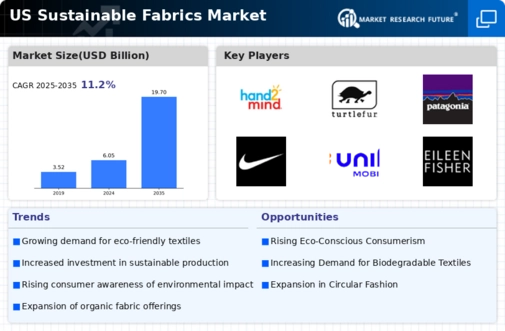The sustainable fabrics market is currently characterized by a dynamic competitive landscape, driven by increasing consumer awareness regarding environmental issues and a growing demand for eco-friendly products. Key players such as Patagonia (US), Eileen Fisher (US), and Repreve (US) are at the forefront, each adopting distinct strategies to enhance their market positioning. Patagonia (US) emphasizes innovation in sustainable materials, while Eileen Fisher (US) focuses on circular fashion principles, promoting the reuse and recycling of textiles. Repreve (US), known for its recycled polyester, is expanding its partnerships with brands to integrate sustainable practices into mainstream fashion, collectively shaping a competitive environment that prioritizes sustainability and ethical production.
In terms of business tactics, companies are increasingly localizing manufacturing to reduce carbon footprints and optimize supply chains. The market structure appears moderately fragmented, with numerous players vying for consumer attention. However, the influence of major companies is significant, as they set benchmarks for sustainability practices and drive industry standards. This competitive structure encourages smaller brands to innovate and differentiate themselves, fostering a vibrant ecosystem of sustainable fabric solutions.
In November 2025, Patagonia (US) announced a partnership with a leading textile recycling firm to enhance its circular economy initiatives. This strategic move is likely to bolster Patagonia's commitment to sustainability, allowing the company to reclaim and recycle used garments, thereby reducing waste and promoting a more sustainable lifecycle for its products. Such initiatives not only align with consumer expectations but also position Patagonia as a leader in the sustainable fabrics sector.
In October 2025, Eileen Fisher (US) launched a new line of organic cotton garments, sourced from regenerative agricultural practices. This initiative underscores the brand's dedication to sustainability and its efforts to educate consumers about the benefits of organic materials. By investing in regenerative practices, Eileen Fisher (US) not only enhances its product offerings but also contributes to soil health and biodiversity, which may resonate well with environmentally conscious consumers.
In September 2025, Repreve (US) expanded its product line to include a new range of fabrics made from ocean-bound plastic. This strategic decision reflects a growing trend towards utilizing waste materials in fabric production, addressing both environmental concerns and consumer demand for innovative solutions. By tapping into the ocean plastic crisis, Repreve (US) positions itself as a forward-thinking player in the sustainable fabrics market, appealing to brands looking to enhance their sustainability credentials.
As of December 2025, the competitive trends in the sustainable fabrics market are increasingly defined by digitalization, sustainability, and the integration of AI technologies. Strategic alliances among companies are shaping the landscape, fostering innovation and collaboration. The shift from price-based competition to a focus on technological advancement and supply chain reliability is evident, suggesting that future differentiation will hinge on the ability to innovate sustainably and efficiently. Companies that can leverage these trends are likely to thrive in an evolving market that prioritizes ethical practices and environmental stewardship.























Leave a Comment